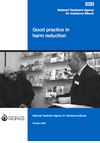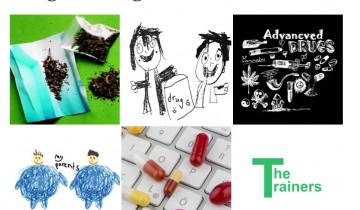Harm reduction
‘Harm Reduction’ refers to policies, programmes and practices that aim primarily to reduce the adverse health, social and economic consequences of the use of legal and illegal psychoactive drugs without necessarily reducing drug consumption. Harm reduction benefits people who use drugs, their families and the community. Harm reduction is not about encouraging or condoning drug use, and drug users should get tailored information from a local drug agency.
Good practice in harm reduction (NTA)

The NTA publication, Good Practice in Harm Reduction (October 2008) helps service providers and commissioners improve harm reduction services for drug users. Good practice in harm reduction aims to demonstrate what works best on the ground, and is based on interviews with those partnership areas that scored highly on the joint improvement review of services carried out by the NTA and the Healthcare Commission. The guide contains case studies showing how gaps in service provision in a range of different areas have been addressed, and demonstrates how the top ten per cent of best performing partnerships carried out the planning and delivery of their services.
Good practice in harm reduction is currently (Nov 2014) available here.
Drug overdose short film
‘Going Over’ was first produced for an overdose campaign in 2002, and has been re-released with it’s ‘sequel’ recovery which was filmed in 2008 to complement Going Over with clear instruction on how to put someone in the recovery position. From the folk at Exchange Supplies.
General risk reduction
All drug use presents risks to the user. However, some of the risk can be reduced. Even with best practice there are still risks associated with using drugs. Some of the suggestions below may help.
- Avoid injecting drugs – other methods of use are a lot safer for your health.
- Use sterile equipment if you do inject.
- Get support.
- Get support.
- Pick a day to reduce and stop. Aim for it. Prepare for it.
- Drink-spiking can and does happen. Don’t accept drinks from people you don’t know.
- Mixing alcohol and drugs will make the effects of both more unpredictable.
- Drink plenty of water, especially when the sun is shining or if you are taking ecstasy or other dance drugs, and moving around a lot – try and drink up to a pint of water every hour.
- Why don’t you do something more useful instead? (remember the TV programme?).
- Don’t mix drugs (including prescription drugs) without checking out how they interact with each other.
- Don’t use by yourself. Make sure that there is someone there to help you in an emergency.
- Consider the risks to the baby and yourself of using during pregnancy.
- Don’t take drugs and drive or use machinery.
- Don’t take drugs to avoid problems – they can make them much worse.
- Remember that in most cases you only think you know what you are buying and taking – there could be any thing in your supply.
- Consider how often you use.
- Never say yes to a drug if you really want to say no.
- Stop if you have to increase the dose to get the same effect – this could mean that tolerance and dependency are building up.
- Learn some basic first aid – ask at a drug agency. You could save a life.
- Learn the signs of overdose. You could save a life.
Specific drug harm reduction
Alcohol
- Avoid injecting drugs – other methods of use are a lot safer for your health.
- Use sterile equipment if you do inject.
- Limit daily intake to 4 units for adult men and 3 units for adult women.
- Don’t use alcohol and other drugs together.
- Don’t drink excessively at any one time.
- Know your limit and stick to it.
- Mixing alcohol and drugs will make the effects of both more unpredictable.
- Don’t drink and drive, or use machinery whilst under the influence.
Amphetamines
- Avoid taking with other stimulants.
- Avoid taking speed if anti-depressants are also being taken; the combination with some types has killed some speed users by sending their blood pressure up very high.
- Avoid taking speed in pregnancy – medical research suggests that amphetamines can damage an unborn baby.
- Avoid keeping on taking speed to put off the come down – there has to be a come down at some time and the longer it is left, the worse it will be.
- Avoid injecting speed – it is often cut with stuff like flour, chalk or paracetamol, which can clot the blood and cause a lot of damage.
- Know your limit and stick to it.
- Avoid increasing the amount of speed taken – if more is needed to get the same effect, take a break from it until it is possible to get back to the first effect from the original amount.
- Make sure plenty of rest and food is taken after a session on speed. A sensible dose of vitamins and calcium may help too.
Cocaine and crack
- Avoid taking with other stimulants.
- Avoid mixing with alcohol – with cocaine, the unintended negative effects of both alcohol and cocaine are increased.
- Avoid keeping taking cocaine or crack to put off coming down. The body has to come down sometime, so the longer it is left the worse it will be.
- It is advisable that users set a limit on the money they can spend on crack – avoid borrowing off friends or buying on credit from dealers.
- Make sure the user gets plenty of rest and food after taking cocaine.
Ecstasy
- Avoid taking other drugs, including alcohol, because ecstasy dehydrates the body.
- To try and avoid heat stroke, wear loose clothing.
- ‘Chill out’ (relax and recover) regularly.
- Make sure you feel fit and healthy in the first place, ecstasy puts a lot of physical strain on the heart, liver and kidneys.
- Make sure if dancing non-stop that around a pint of fluid (not alcohol) is drunk to replace the fluid lost by sweating. Isotonic sports drinks replace the lost body salts very effectively. If the user is not dancing, they will not need as much fluid, as too much can be harmful.
- Make sure users can get home safely – not driving – after ecstasy is taken.
- Drink plenty of water, especially when the sun is shining or if you are taking ecstasy or other dance drugs, and moving around a lot – try and drink up to a pint of water every hour.
- Avoid taking more ecstasy once the initial effects have worn off – this strains the system and makes coming down worse.
- Avoid taking ecstasy if you are depressed or anxious as use may exacerbate the problem.
- Avoid increasing the amount of ecstasy that is taken – if more is needed to get the same effects as the last time – take a break from it.
- Remember water is not an antidote to ecstasy. It just helps prevent dehydration.
Heroin
- Refer to general suggestions.
- Try to avoid injecting – there are much safer ways of using, and they will give your veins a chance to recover from the damage caused by injecting.
- Allow at least 3 or 4 days between each use, if you intend to use heroin again. The delay helps your body to recover.
- Heroin dependency does not form instantly – watch for increasing use. Dependency can creep up on you.
- Most of the health risks with heroin come from injecting, but smoking can lead to chest problems, overdose and dependency.
- If heroin is injected, it is vital that equipment is not shared, as blood borne viruses (e.g. Hepatitis and HIV) can be passed on easily, seek advice from a local agency or use the internet.
- Injecting drugs presents a possible risk of HIV and hepatitis transmission only if the injecting equipment is shared with other users. Other health risks can include abscesses, swelling, other blood borne infections, and possible blood clots leading to loss of limb.
LSD
- Refer to general suggestions.
- If you are planning a trip, allow about twelve hours for the effects to fade.
- Make sure it is taken with someone they know and trust preferably someone who has used it before and knows how strong the effects can be.
- It is advisable that users set a limit on the money they can spend on crack – avoid borrowing off friends or buying on credit from dealers.
- Trips can last up to 12 hours – ensure that users are somewhere where they feel safe and secure and have somewhere safe to go to afterwards, when the club shuts. Make sure if someone is experiencing a bad trip, they are looked after. Reassure them that what they are feeling is drug induced and that they are not going mad. Nothing can bring them out of the trip quickly, but quiet, patient reassurance over a couple of hours usually helps.
- Advise not to take LSD if the person is upset or feeling low. It’s more likely they will have a bad trip.
- Advise against taking more – LSD is rarely fake, but may take a while before they feel the effects. If they do take more, they will have to live with a much stronger experience then they anticipated.
- if someone is having a bad trip, avoid flashing lights and music. Find a friend to take them to the chill out area.
Nitrites
- Remember safer sex – poppers may affect judgement during sex.
- Safer sex activists have said of poppers, “If you are going to use poppers, put a condom on before you sniff.”
- Anybody who suffers from circulatory problems or from low blood pressure should be particularly wary of this substance.
- Using poppers can be a serious health risk for those with heart trouble, breathing problems, or anaemia and glaucoma. Always wash off any amyl that spills on your skin and never drink the stuff – it is highly poisonous.
- It’s very dangerous to take poppers with viagra or if you’re on medication to reduce your blood pressure as it can cause it to drop so low it is dangerous.
- Note that poppers may suppress the immune system.
Solvents and gases
- Don’t put a plastic bag over your head.
- Don’t squirt lighter-fuel aerosols straight into your mouth.
Tobacco
- Give up!! That’s what specialist tobacco workers say.
- Don’t inhale so deeply.
- Cut down on the number you smoke.
- Be aware of the effects of smoking on your baby and passive smoking generally.
Tranquillisers
- Ask if you really need to take them for more than a few weeks.
- If taken for too long they become ineffective by dependence develops.
